Imagine this: you’re in your office with spreadsheets showing your marketing budget being cut and customer acquisition costs soaring. This resonates with you? You are definitely not alone.
Marketing budgets are tight. Privacy legislation is complicating tracking. User acquisition costs keep rising. These challenges are real and widespread.
What do we do? Enter Media Mix Modeling (MMM), not just another analytics tool that is collecting dust on your dashboard and is waiting to be noticed. MMM is your strategic guide for improved effectiveness, improved results and enhanced insights into what your ROI means.
As marketers adapt to these new challenges, reliable mobile measurement partners such as Apptrove know that sophisticated measurement solutions are vital. With privacy regulations growing more stringent and conventional attribution sources becoming less reliable, Media Mix Modeling is a strategic solution that mobile-first brands need to consider for sustainable growth and effective performance measurement.
In this ultimate guide, we will cover everything you need to know about MMM, from current best practices to emerging approaches being employed by leading industry brands.
What Is Media Mix Modeling?
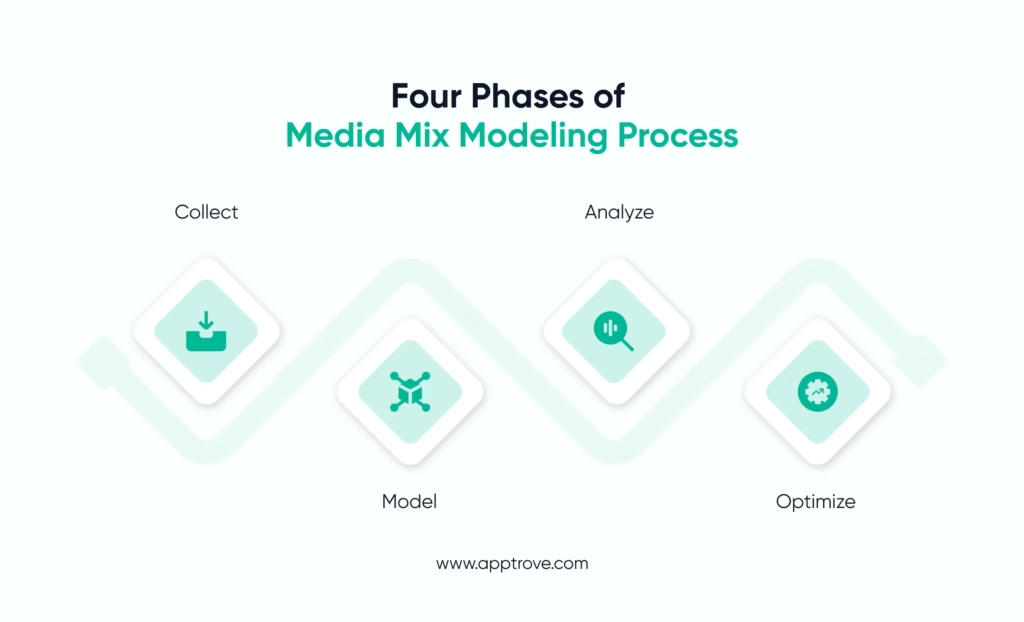
Media Mix Modeling (MMM) is a statistical tool that provides insights to marketers as to which marketing avenues are truly being a difference maker in business results. Rather than relying on last-click attribution or base their decisions on gut instinct, MMM leverages historical data to uncover marketing effectiveness.
Consider media mix modeling as your marketing investigator. It looks at every campaign – from TV ads to social, influencer relationships to email and give you the insight as to which marketing activity is making an impact on your business.
The beauty of Media Mix Modeling is it pulls everything together. It never examines only the digital channels in isolation. It takes into account everything: offline advertising, seasonality, competitors, even externality factors like weather patterns or economic conditions that might drive your customers behaviors.
What is media mix modeling in simple terms? It is your answer to three important questions that keeps marketers thinking:
- Where should I infuse more money to drive better return?
- What marketing channel should I pull back on to not hurt performance?
- How do different marketing avenues work together to drive overall better result?
Why Media Mix Modeling Matters More Than Ever in 2025
The marketing environment has changed dramatically in the most recent years. The 2025 outlook: As user-based data – such as third-party cookies – become more difficult to access, marketers will turn towards MMM even more than before. According to e-Marketer, implementing better, faster MMM is the first priority for U.S. marketers upgrading their measurement tactics.
Due to the difficulty in measuring marketing impact across different channels, effective media mix modeling capabilities are absolutely critical for savvy marketers to stay ahead.
Privacy mandates (e.g. GDPR, CCPA, and many state-based laws) have restricted the ability to gather data. iOS 14.5 has made user tracking annoyingly difficult, and it seems every day we learn that our traditional attribution paradigms get less accurate.
But here’s the game-changer: Media Mix Modeling doesn’t rely on individual user tracking. It works with aggregated data, making it privacy-compliant by design. This makes MMM particularly valuable for app marketers who need to navigate complex attribution challenges.
Mobile marketers face unique hurdles that make mixed media modeling even more critical:
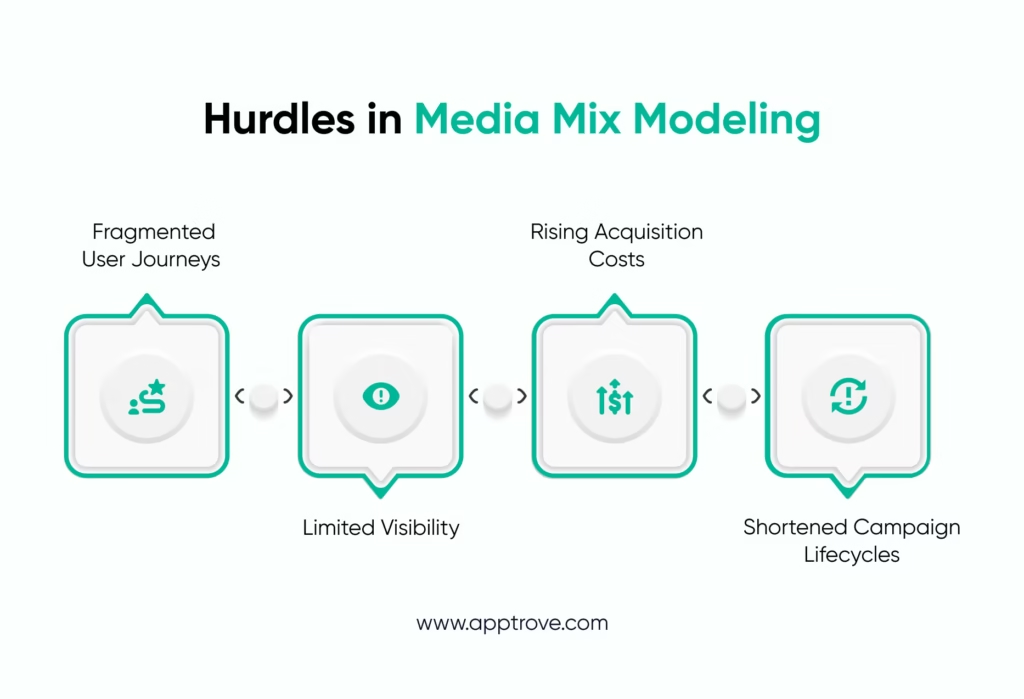
- Fragmented user journeys across multiple devices and platforms
- Limited visibility into cross-channel impact and interaction effects
- Rising acquisition costs that demand better budget optimization
- Shortened campaign lifecycles requiring faster decision-making
Media Mix Modeling addresses these challenges head-on by providing a macro-level view of marketing performance. It’s not about tracking individual users (which is increasingly difficult anyway). It’s about understanding patterns and trends that drive sustainable business growth.
How Does Media Mix Modeling Work?
Tools for media mix modeling use sophisticated statistical analysis of previous marketing data. There is a specific procedure to follow that ultimately builds a broader understanding of your marketing effectiveness:
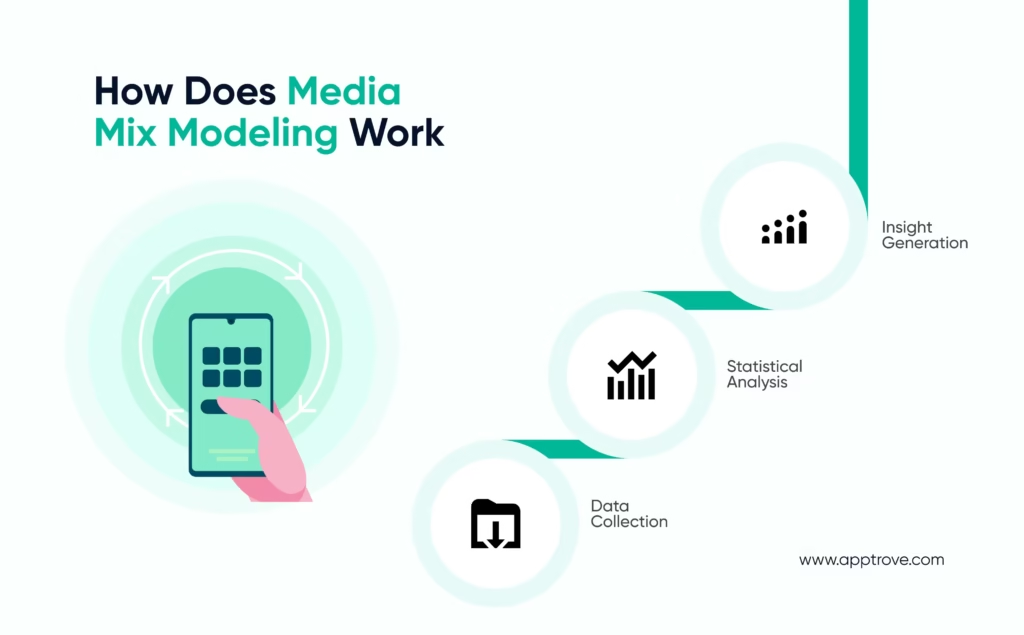
Data Collection: The Foundation of Success
Comprehensive data collection is the groundwork of any media mix model. This process entails gathering all the marketing spend data across all channels, which includes your digital and traditional advertising investments. In addition, you’ll need the detailed business outcomes, such as your sales performance, app installs, conversions, revenue data, etc. External factors play a critical role, such as seasonal patterns, holiday effects, competitor activity, economic indicators. Additionally, it is best to include all media impressions, reach metrics, engagement statistics, customer behavior metrics, and demographic information to provide a complete holistic and comparative picture for evaluation and referencing.
Statistical Analysis: The Engine Behind Insights
The heart of media mix modeling is complex regression analysis. In this process you look for data patterns and utilize regression to identify relationships between marketing variables and business outcomes. More importantly, the media mix model accounts for the simultaneous interactions involving multiple variables including both direct effect of each marketing channel on performance and interaction across channels. The media mix model also accounts for diminishing returns with increased spending via saturation curves, time-decay of marketing activity effects, and temporal patterns as well as other market forces.
Insight Generation: Converting Data into Action
At the end of your mixed media modeling process, you are left with actionable insights to transform your marketing decisions. Although there are several insights from this process, three you will find useful are identifying contribution of each marketing channel to total performance, determining budget allocation across multiple media channels, and identifying saturation curves that illustrate when to stop spending because additional dollars will not be effective. The model also provides scenario planning capability for future budget considerations and thorough measurement of results across all marketing touchpoints to measure ROI for your company.
Key Benefits of Media Mix Modeling
1. Budget Optimization That Works
Media Mix Modeling will tell you where your marketing dollars are doing well. You can see under-delivering channels and shift budget into high-quality areas with assurance. 83% of marketing leaders now say showing ROI is their main focus compared to 68% five years ago, so this value is more important than ever.
2. Shared Understanding and Cross-Channel Synergy
Whereas traditional attribution tends to towards engagements rather than considering the quality of the touchpoints, media mix modeling tools help you understand how multiple channels are connected. You may see that the search volume from your TV campaigns has become significant, or your social media advertisement might appear as successful because of influencer marketing.
3. Strategic Planning
While MMM gives access to accuracy for papers that degenerate into your daily tactics, collecting statistical evidence to inform longer-term media investment justifies your marketing expenditure and connects to a business environment.
4. Privacy-Safe Measurement Solution
Since MMM picks confidence working with aggregated data to developers rather than data from individual users it is naturally privacy compliant. It is future-proof for solutions that innovate around privacy where conventional tracking that is becoming obsolete.
5. Scenario Planning & Forecasting
Curious what will happen if you increase your social media budget by 20% or move spend from search towards video? Media mix model tools can model two distinct scenarios and forecast potential outcomes so you can consider changes in spending before implementing them.
Media Mix Modeling vs Traditional Attribution
When deciding on which measurement approach is right for your business, it is important to understand the differences between Media Mix Modeling and traditional attribution:
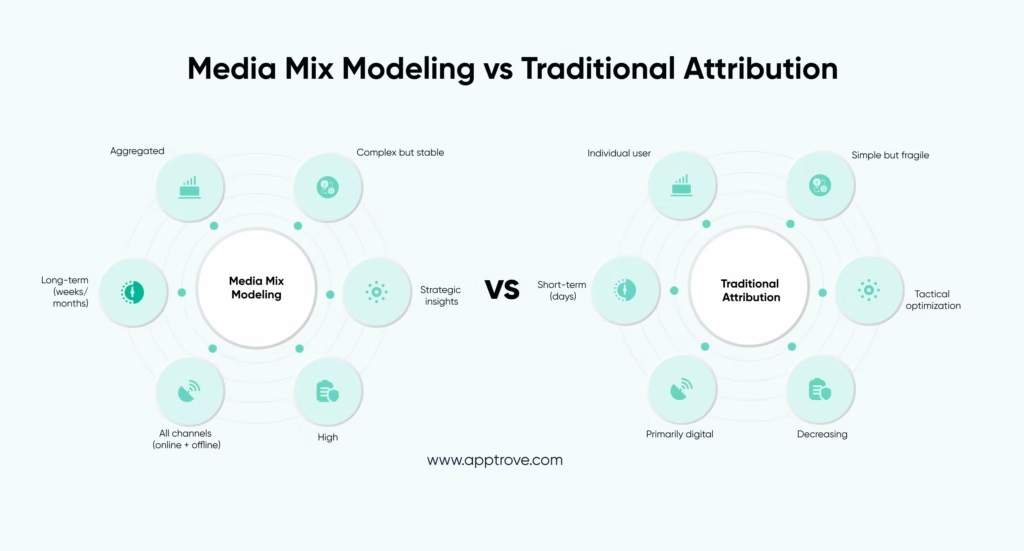
There is a place for both in marketing today. Media Mix Modeling is incredibly valuable for strategic and sophisticated planning, as well as budget allocation, whereas attribution models are better suited for tactical optimization and immediate campaign enhancement.
Importance of Media Mix Modeling Tools
The right set of tools for media mix modeling can decide the fate of your MMM. At Apptrove, we offer an integrated media mix modeling solution purpose-built for app-first brands to solve mobile marketing problems. Our platform combines media mix modeling and mobile attribution, giving you an orginal perspective of your app marketing outcomes.
Key features include:
- Mobile-native with app-specific metrics
- Real-time data integration and processing
- Privacy-compliant measurement framework
- Advanced scenario planning capabilities
- Seamless integrations with big ad platforms
When making a decision on which media mix modeling tools to use, there are important factors to keep in mind. Your teams technical capabilities and available resources will greatly impact which solution is the best fit. Budget limitations and desired ROI have to align with the pricing model and potential returns of the tool. You will also have to consider channel coverage needs and whether or not the platform can integrate with existing data sources. A major consideration is integration needs with existing systems, and whether or not you have vendor support and training available which can make a significant difference in the implementation process.
Building Your First Media Mix Model: A Step-by-Step Approach
Are you ready to apply Media Mix Modeling? Here is a detailed step-by-step process that is recommended by many experts in the field:
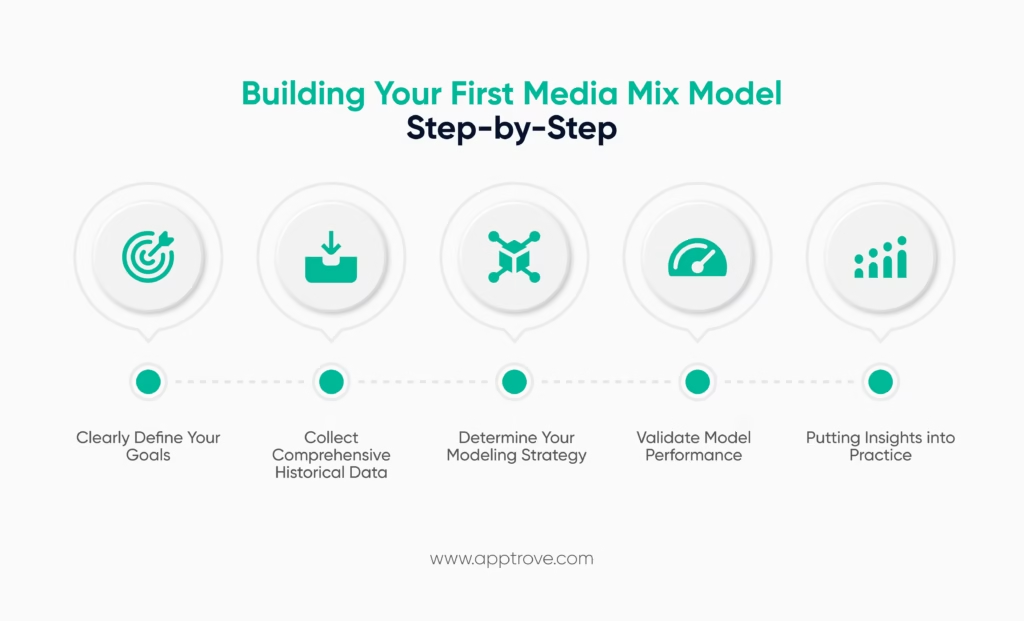
Step 1: Clearly Define Your Goals.
Think first about what you’ll want to get out of mixed media modeling. You may want to understand how to best distribute your budget across channels so that you achieve the best performance, understand what true channel performance looks like, understand the way each channel contributes to the business’s overall goals, set up for forthcoming campaigns with data based insights, or justify your marketing spend to your leaders and stakeholders with actual evidence.
Step 2: Collect Comprehensive Historical Data.
It’s a good practice to collect at least 12-24 months of solid historical data with as many dimensions as possible. Effective analysis involves collecting as much market spend by channel and campaign, business outcome data (Sales, Installs, Conversions, Revenue figures, etc.) as you can find; External data points (seasonality patterns or events to keep in and/or consider), competition activity data; All media performance data (impressions, clicks, engagements, etc.); Customer behavior data (when a customer interacts with a channel) and their relevant demographic data (e.g. region, gender, age range, etc.) that puts context around your analysis.
Step 3: Determine Your Modeling Strategy
Select your modeling strategy based on your organization’s capabilities and needs. Building in-house takes a fair amount of data science skill and equipment, but you have full control over the process. Using vendor solution like Apptrove gives you a quicker implementation and ongoing support for someone looking for an “easy” button. This option is best when time is of the essence and you desire results as soon as possible. If you choose the consulting option, there are consulting firms who specialize in statistical modeling without making a long-term commitment to hire staff. Consulting is the best option if you are looking for the proper level of guidance and support, while remaining a nimble organization.
Step 4: Validate Model Performance
Check the accuracy of your media mix model through various forms of validation to assess its accuracy and build in reliability. Validation is done through verifying compared predicted results with actual results, but over long time spans to verify results in consistency. True holdout testing with control group testing, checking model predictions in industry ruled testing, can provide peace of mind. Cross-validating as to value impact with other measures would also provide comfort in its accuracy. Finally, testing model performance, stability, and accuracy across time periods is prudent as data could project selling results differently in changing market conditions.
Step 5: Putting Insights into Practice
Using the insights you gained from the Childhood Media Mix Modeling study to positively impact your business across the entire marketing organization involves shifting budgets between different channels based on legitimate channel performance data, shift your campaign approaches and creative executions for better campaign success, etc. It also helps to enhance or solidify future media investments with greater confidence, and have defendable results to communicate with stakeholders.
Step 6: Management and Continuous Refinement
Media Mix Modeling is meant to be an active process, not a point in time exercise. Institutions should develop processes to evolve their model on an ongoing basis with new data. Maintaining a high level of accuracy will be dependent upon periodically refreshing the model with fresh data as well as refining parameters based on actual results. Institutions should also expand with different channels and touchpoints over time as their marketing strategies evolve. They should test the insights with the market and experimentation to validate decision confidence.
Mixed Media Modeling for Mobile Apps: Unique Considerations
Mobile app marketers face challenges that make mixed media modeling extremely valuable and helpful:
Complexity in Managing Cross-Channel Platforms
Users discover apps from various points of contact—social media discovery, related search queries, personal word-of-mouth recommendations, or organic browsing in the app store. Media mix modeling algorithms help unwind the complex journey taken by a user to parameterize the appropriate value.
Attribution Challenges in the Privacy Era
With the recent trend of iOS 14.5 and other similar privacy updates limiting traditional tracking horizons, media mix modeling Measurement of apps will provide an alternative measurement methodology that does not rely on user-level tracking. With privacy concerns becoming an increasing reality around the globe, the organizational twist on applying the modelling approach should be offering more and improved value.
Channel Diversification and Expansion
App marketers are making progress in their regular practices of digital marketing channels to evolve into other areas of growth advertising, such as Connected TV, Influencer Marketing, and offline advertising. Media mix modeling provides a more precise perspective on estimating, measuring, and understanding the shifts in progress from new channels.
Lifecycle Marketing Optimization
If the ‘solutions your media mix model are estimating how communication strategies impact each step of the user journey, you will be able to present a more holistic marketing experience based on more controlled testing to inform your decisions without constraint.
Advanced MMM Tactics for the Savvy Marketer

1. Incremental Testing Integration
A great combination of Media Mix Modeling and geo-testing strategies helps you take your learnings and validate against somewhere (in a different place). By running a campaign in test markets and then comparing that to predicted behavior from the MMM, certainly this will improve the prediction accuracy.
2. Real-time Optimization Capability
Previous to this point, MMM was retrospective without real-time data perceived through quick data feeds or applying situational and or context-based up-to-the-second feeds from your manufacturers.
3. Cross-Platform Modeling Processes
Bring your mix media modeling to life by expanding the mix beyond paid media to include owned, earned, and other customer engagement lifecycle touchpoints.
4. Predictive Analytics
MMM does allow you to peer into the future and better predict the future based on alternate expense projections. This is valuable to the annual planning and prospective budgeting process.
Common MMM Barriers to Adoption and Implementation
Data Quality Represents The Biggest Threat
Poor data quality represents the biggest threat to successfully implementing Media Mix Modeling. Specific issues or liabilities might include: disparate data collection approaches; methodological inconsistencies across channels introduced gaps related to understanding; missing data points that occurred everywhere but the MMM during critical timeframes; unexpected charged biases from agencies, and so many other biases; misaligned reporting windows and measurement periods that bias the ultimate outcomes; considerable gaps in primary external factor data collection heightens risks to not including contextual variables and factors.
Solution – Before implementing MMM, we recommend working towards good data infrastructure for data governance and best practices across all platforms.
Management of Model Complexity
Media mix models that are overly complicated can create challenges when we are trying to understand and operationalize. There is often a temptation to include every potential variable.
Solution: Start with the core channels to keep it simple and then add complexity as the team becomes more proficient and confident.
Adoption Challenges at Organizations
Insights from mixed media models can only help if they are used in decision-making. Getting key stakeholder buy-in can be challenging.
Solution: Get buy-in from key stakeholders early and ensure the team is trained on how to interpret results, and apply learnings.
Technical Knowledge Gaps
MMM requires statistical knowledge and technical competence that marketing teams often do not possess in-house.
Solution: Train your current team or align with experts like at apptrove to ensure successful implementation.
The Future of Media Mix Modeling
The MMM space is rapidly changing due to technological advancement and market change. The following are important trends to keep an eye on:
AI-Powered Modeling Revolution
Machine learning and artificial intelligence are now enabling the tools that support media mix modeling to be more accurate and easier to deploy. AI can identify patterns automatically, and optimize model parameters without direct manual efforts.
Real-Time Insights Evolution
Mixed Media Modeling in its original form was generally historical. While many of the more advanced solutions are transiting to real-time or near-real time insights, which allow for faster decisions based on that data.
Automated Optimization capabilities
The more advanced media mix modeling platforms will be able to automatically optimize media spend based on the recommendations of the model, thus eliminating much of the manual work and ability to react faster.
Greater Integration & Marketing ecosystems
Media Mix Modeling should continue it’s move towards integration into other marketing tools, that can lead towards unified measurement ecosystems that offer an overall business intelligence solution.
Measuring The Performance of Media Mix Modeling
How do you know that you have implemented Media Mix Modeling correctly and reaped the benefits? There are many dimensions through which you can measure your success.
First, model accuracy metrics will provide you with some technical validity, both R-squared values will provide you with a view on the quality of fit, and mean absolute percentage error (MAPE) will provide the prediction level accuracy. Second, you should be keeping track of your prediction accuracy; third, over longer periods of time; fourth, as well as model stability regardless of varying market conditions.
Business impact measurements demonstrate the real-world value of your MMM investment. Look for improved ROI across marketing channels, which indicates better resource allocation. Better budget allocation decision outcomes show that insights are being applied effectively. You should also measure reduced wasted spend on underperforming activities and track increased overall marketing efficiency as key success indicators.
Organizational adoption indicators reveal whether your team is truly embracing MMM insights. Monitor the frequency of MMM insight usage in decision-making processes, as this shows practical application. Stakeholder satisfaction with model outputs indicates acceptance and trust in the system. Decision-making speed improvements demonstrate operational benefits, while strategic planning quality enhancements show long-term value creation.
Best Practices for MMM Success
1. Start Simple and Scale Gradually: Begin with a basic media mix model covering your main channels. Add complexity and sophistication as you gain experience and confidence with the methodology.
2. Invest in Data Quality Infrastructure: Clean, consistent data is the foundation of successful mixed media modeling. Invest in data infrastructure and governance processes before rushing into modeling.
3. Combine with Other Measurement Methods: MMM works best when combined with other measurement approaches. Use it alongside attribution modeling, experimentation, and customer surveys for comprehensive insights.
4. Regular Updates and Maintenance: Update your media mix modeling tools regularly with new data and market insights. MMM is not a set-it-and-forget-it solution—it requires ongoing attention.
5. Focus on Actionability Above All: Ensure your Media Mix Modeling insights are actionable and relevant to business decisions. Complex models are useless if they don’t drive better marketing outcomes.
MMM for Different Business Types
E-commerce and Online Retail
Focus on conversion tracking and customer lifetime value optimization. Model the impact of promotional activities, seasonal trends, and competitive pricing strategies.
Mobile Apps and Digital Products
Emphasize user acquisition and retention metrics. Consider the full user journey from initial install through monetization and long-term engagement.
B2B and Professional Services
Model longer sales cycles and multi-touch attribution patterns. Include lead quality metrics and pipeline contribution measurements in your analysis.
Retail and Consumer Goods
Integrate online and offline data sources effectively. Consider foot traffic, store visits, and cross-channel shopping behavior patterns in your modeling.
ROI Calculation for Media Mix Modeling Investment
Calculating the return on investment for your Media Mix Modeling implementation involves multiple factors that contribute to overall business value:
Direct Financial Benefits
Direct financial benefits include reduced wasted spend through better allocation decisions, improved channel performance and efficiency gains, enhanced budget allocation accuracy, and increased overall marketing ROI. These measurable improvements often justify the investment within the first year of implementation.
Indirect Business Benefits
Indirect business benefits, while harder to quantify, often provide substantial long-term value. These include faster decision-making capabilities that improve competitive response times, improved stakeholder confidence in marketing investments and strategies. Better strategic campaign planning leads to more effective initiatives, while enhanced competitive positioning strengthens market standing over time.
Cost Considerations & Planning
Cost considerations and planning require careful evaluation of multiple investment areas. Tool licensing fees and platform costs represent the most visible expenses, while implementation and setup expenses can vary significantly based on complexity. Ongoing maintenance and support costs should be factored into long-term budgeting, and training and education investments ensure your team can maximize the platform’s value.
Integration with Marketing Technology Stack
Media Mix Modeling doesn’t operate in isolation, it should integrate seamlessly with your existing marketing technology ecosystem:
Data Sources Integration
Data sources integration involves connecting with ad platforms like Google, Facebook, Amazon, and TikTok to pull performance data automatically. Analytics tools such as Google Analytics and Adobe Analytics provide additional behavioral insights, while CRM systems and customer databases add valuable customer context. Customer data platforms and data warehouses serve as centralized repositories for comprehensive analysis.
Output Destinations & Applications
Output destinations and applications ensure that MMM insights reach the right stakeholders in usable formats. Business intelligence and reporting tools help visualize complex data relationships, while campaign management and optimization platforms can automatically apply recommendations. Budget planning and forecasting systems integrate MMM insights into financial planning processes, and executive reporting dashboards provide high-level summaries for leadership presentations.
Making MMM Work for Your Brand
Media Mix Modeling isn’t just a nice-to-have analytics tool anymore. It’s becoming essential for marketers who want to thrive in a privacy-first, budget-conscious world where every dollar spent needs to deliver measurable results.
Remember, mixed media modeling is a journey, not a destination. The most successful implementations start simple and evolve over time, building sophistication and accuracy as teams gain experience and confidence.
Whether you’re a mobile app marketer struggling with iOS 14.5 attribution challenges or a multi-channel brand looking to optimize your media mix model, MMM can provide the insights you need to make smarter marketing decisions and drive sustainable business growth.
The question isn’t whether you should implement Media Mix Modeling. According to e-Marketer, 61.4% of U.S. marketers are looking to augment measurement strategies with better and faster media mix modeling. The question is how quickly you can get started and begin realizing the benefits that come with data-driven decision making.
Ready to Transform Your Marketing with Media Mix Modeling?
Don’t let budget uncertainty and attribution challenges hold back your growth potential. As a reliable mobile measurement partner, Apptrove understands the complexities that mobile-first brands face in today’s measurement landscape.
Media Mix Modeling isn’t just a trend, it’s becoming essential infrastructure for sustainable marketing growth. The shift toward privacy-first measurement requires sophisticated solutions that can deliver accurate insights without compromising user privacy.
Whether you’re looking to optimize budget allocation, understand true channel performance, or navigate the evolving attribution landscape, partnering with experienced mobile measurement experts can accelerate your MMM implementation and ensure you’re maximizing every marketing dollar.
Transform your marketing strategy, optimize your budget allocation, and maximize your ROI with confidence through proven Media Mix Modeling approaches.
Frequently Asked Questions (FAQs)
1. What is media mix modeling and how does it differ from attribution?
Media Mix Modeling is a statistical approach that analyzes historical marketing data to understand the impact of different marketing channels on business outcomes. Unlike attribution models that track individual user journeys, mixed media modeling works with aggregated data and provides strategic insights for budget allocation. It’s privacy-compliant and covers both online and offline channels, making it more comprehensive than traditional attribution methods.
2. How long does it take to implement media mix modeling tools effectively?
The implementation timeline for media mix modeling tools varies depending on your approach. Using a vendor solution like Apptrove can get you up and running in 4-8 weeks, while building an in-house media mix model typically takes 3-6 months. The key factors affecting timeline include data quality, technical complexity, and team expertise. Most organizations see initial insights within the first month of implementation.
3. What data is required for successful media mix modeling?
Successful media mix modeling requires at least 12-24 months of historical data including: marketing spend by channel, business outcomes (sales, conversions, installs), external factors (seasonality, competitor activity), and media performance metrics (impressions, reach). The more comprehensive and clean your data, the more accurate your mixed media modeling results will be.
4. Can small businesses benefit from media mix modeling or is it only for large enterprises?
Media Mix Modeling can benefit businesses of all sizes, though the approach may differ. Small businesses can start with simplified media mix modeling tools and basic models covering their core channels. While enterprise solutions offer more sophisticated features, affordable options and open-source tools make media mix modeling accessible to smaller organizations with modest budgets and technical resources.
5. How often should we update our media mix model and what triggers a refresh?
Your media mix model should be updated regularly to maintain accuracy. Most successful implementations refresh their mixed media modeling analysis monthly or quarterly, depending on business dynamics. Key triggers for updates include: significant changes in marketing strategy, new channel launches, major market shifts, seasonal pattern changes, or when model accuracy begins to decline. Regular updates ensure your media mix modeling tools continue providing relevant insights.





